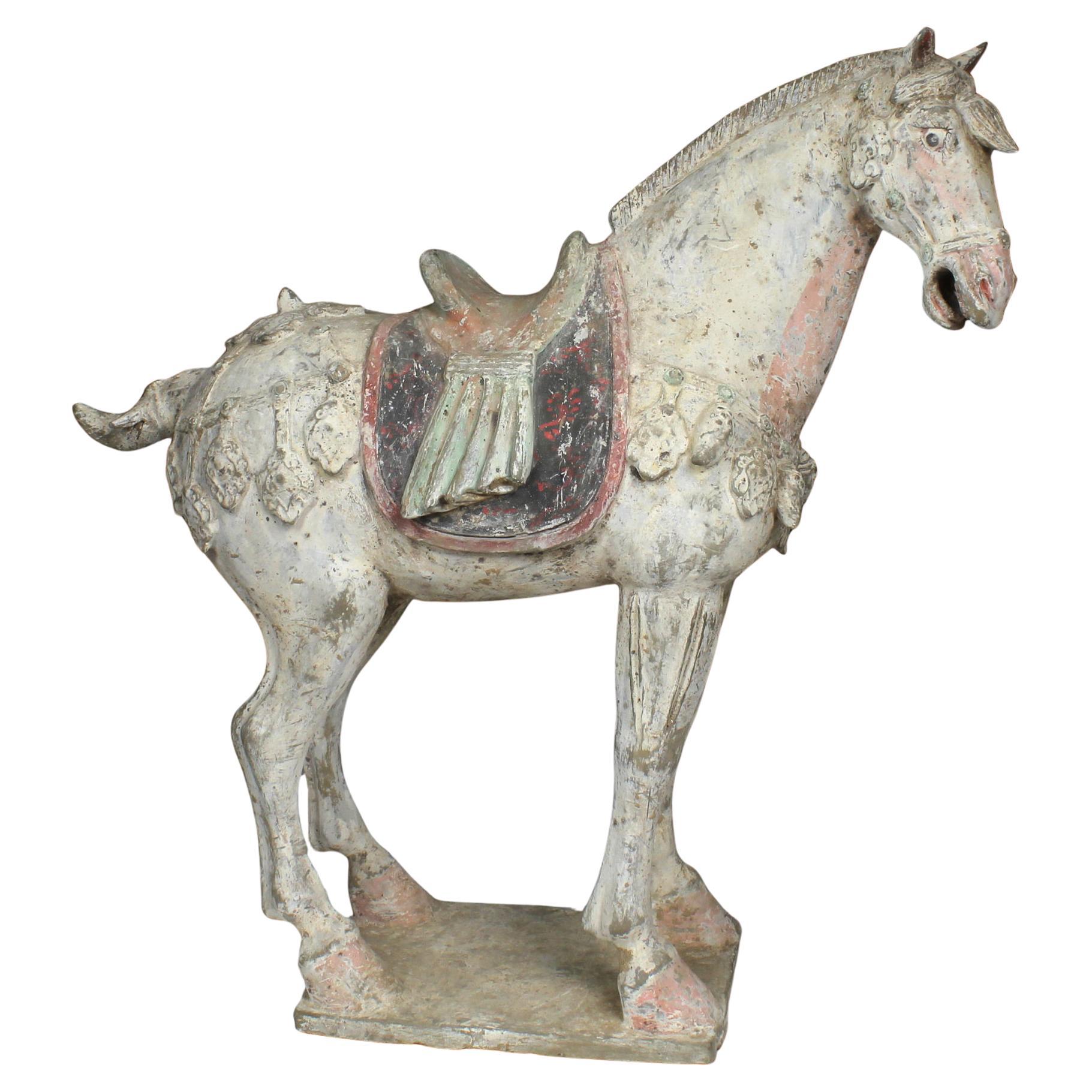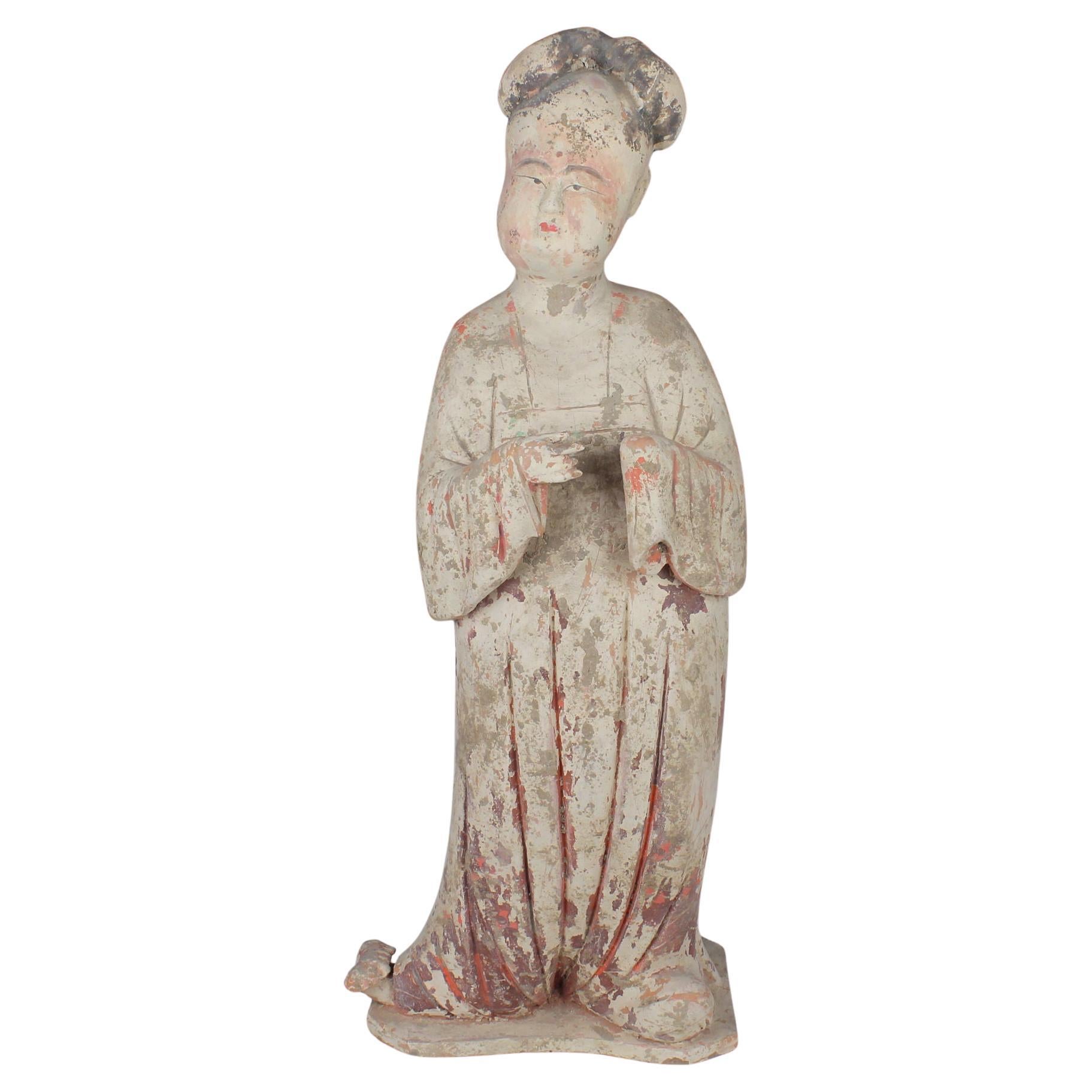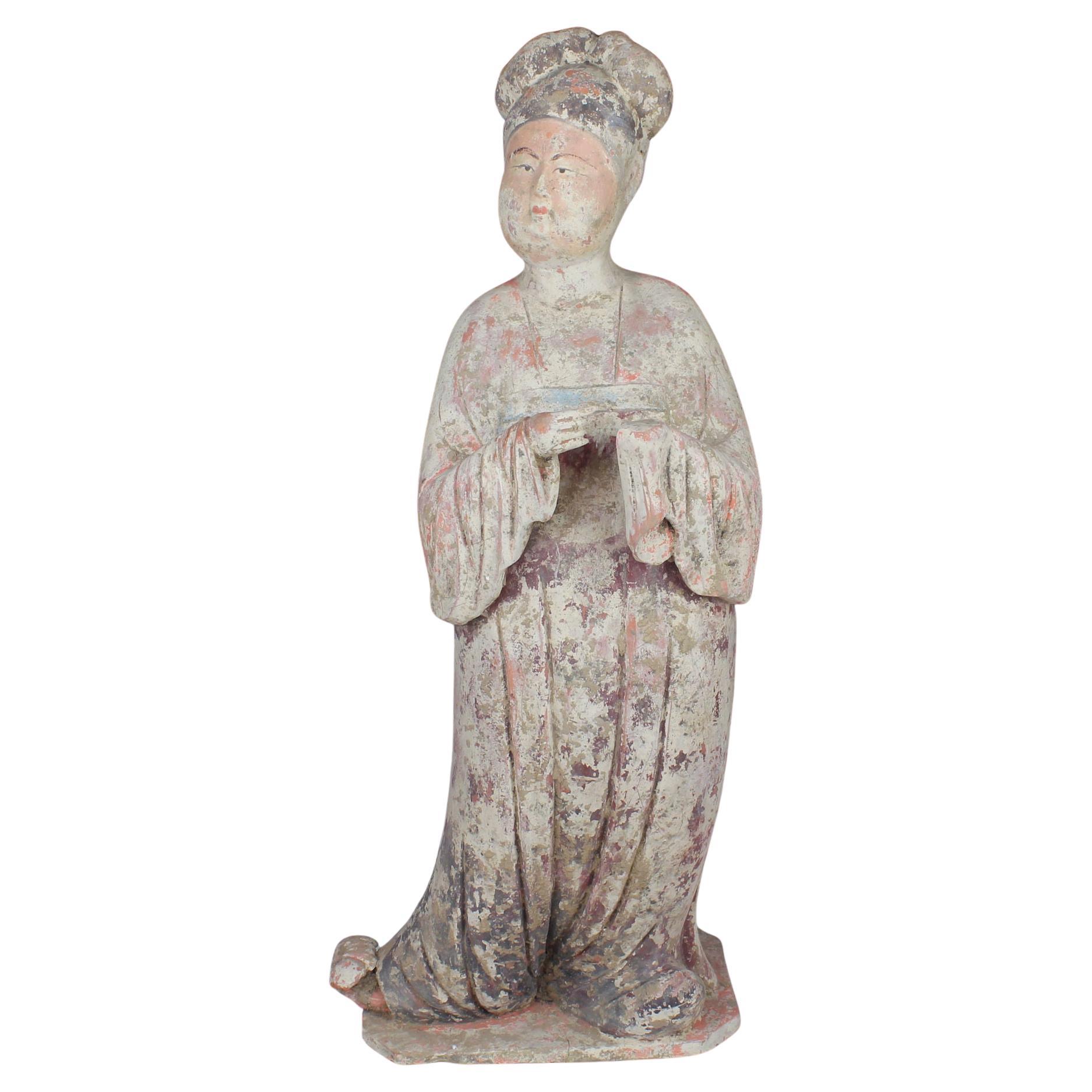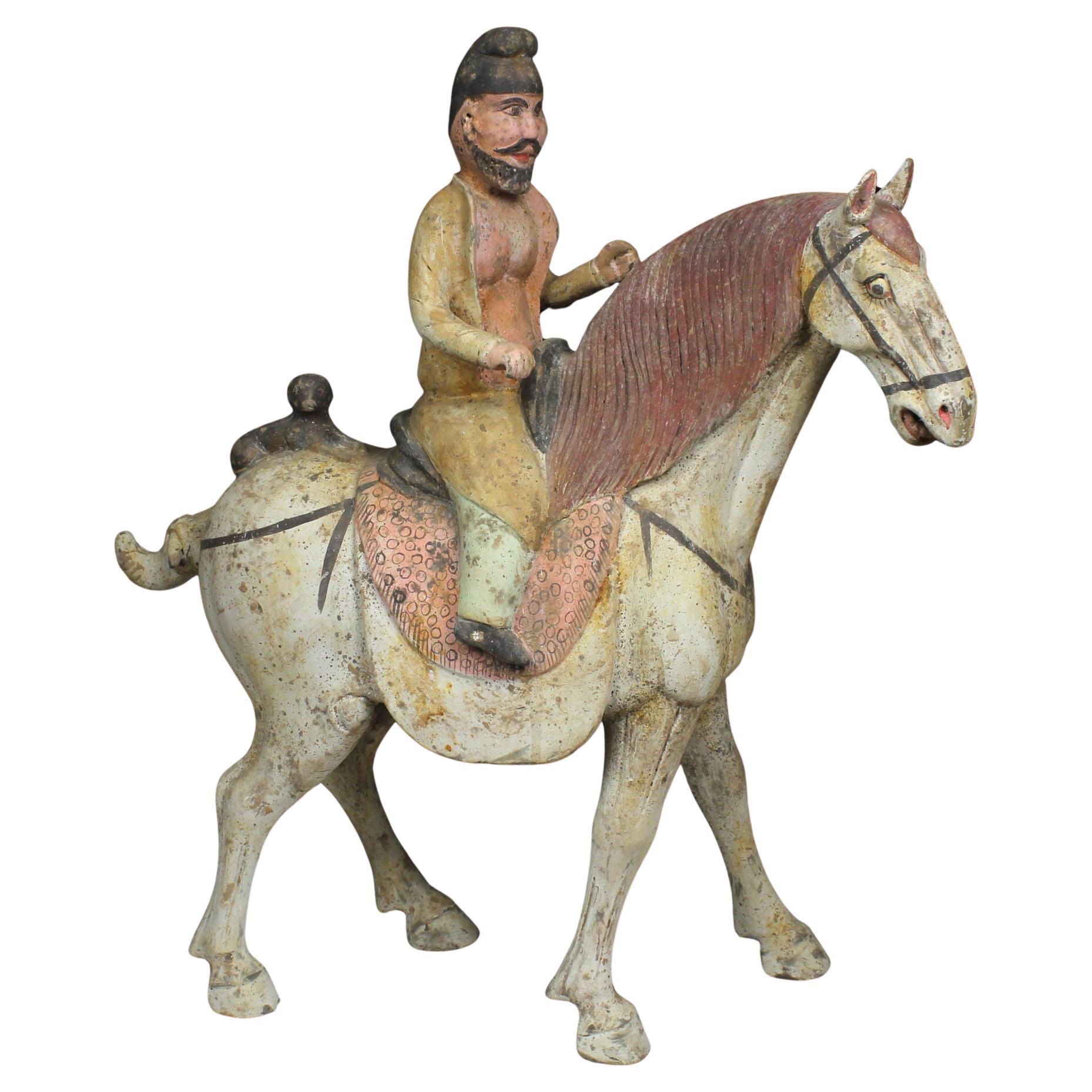Want more images or videos?
Request additional images or videos from the seller
Chinese statuette of a horse
About the Item
ITEM: Statuette of a horse
MATERIAL: Pottery
CULTURE: Chinese, Northern Wei Dynasty
PERIOD: 386 – 535 A.D
DIMENSIONS: 404 mm x 350 mm x 230 mm
CONDITION: Good condition. Includes Thermoluminescence test by Laboratory Kotalla (Reference 02PR180521)
PROVENANCE: Ex Belgian private collection (2022), Ex English art gallery, Ex English private collection, Ex Hong Kong art collector, acquired in the early 1990s
Comes with Certificate of Authenticity and Export Licence. If you are from outside the European Union, we will have to apply for the export licence again for your country, this takes 4 to 6 weeks.
Due to the fragility and size of this piece, it can only be shipped within the European Union, United Kingdom and neighbouring countries that can be transported by road by private courier (door to door).
The Northern Wei Dynasty, which reigned from 386 to 534 AD, was a pivotal period in Chinese history characterized by a fusion of nomadic and Han Chinese cultural influences. Founded by the Tuoba clan of the Xianbei people, the dynasty was marked by significant territorial expansion and cultural achievements. The Northern Wei Dynasty played a crucial role in the Sinicization of northern China, adopting many aspects of Han Chinese culture while retaining elements of their own nomadic heritage. This period saw advancements in art, literature, and Buddhism, with the latter becoming the state religion during the reign of Emperor Xiaowen, who initiated policies to sinicize the dynasty further.
One of the remarkable cultural artifacts from the Northern Wei Dynasty is the Horse Minqi statuettes. These miniature horse sculptures, typically crafted from ceramic, are renowned for their exquisite detail and craftsmanship. The Horse Minqi statuettes are believed to have served various purposes, including burial goods, offerings, and decorative items. They often depict horses in dynamic poses, capturing the vitality and grace of these animals. Some sculptures also feature riders, reflecting the importance of horsemanship and cavalry in Northern Wei society.
The Horse Minqi statuettes not only showcase the artistic achievements of the Northern Wei Dynasty but also provide valuable insights into the cultural and military practices of the time. Horses held great significance in nomadic cultures, symbolizing power, mobility, and prestige. As such, the production of these statuettes highlights the importance of horses in Northern Wei society, both in practical terms, such as transportation and warfare, and in symbolic and cultural contexts.
北魏是公元386年至534年间统治中国的一个重要时期,其特点是融合了游牧和汉族文化的影响。由鲜卑族拓跋氏建立,北魏朝廷以颇具影响力的领土扩张和文化成就而著称。北魏时期对中国北方的汉化进程起到了至关重要的作用,他们吸收了许多汉族文化的元素,同时保留了自己游牧民族的传统。在北魏朝,艺术、文学和佛教都有所发展,佛教在孝文帝时成为国教,他还推行了一系列的汉化政策。
北魏时期的马闽器雕塑是一系列引人注目的文物之一。这些小型马雕塑通常由陶瓷制成,以其精湛的细节和工艺而闻名。马闽器雕塑据信用于各种用途,包括作为葬礼品、祭品和装饰品。它们经常描绘马匹的动态姿态,捕捉到了这些动物的生机与优雅。一些雕塑还描绘了骑手,反映了北魏社会中骑术和骑兵的重要性。
马闽器雕塑不仅展示了北魏时期的艺术成就,还为我们提供了宝贵的文化和军事实践见解。在游牧文化中,马具有重要的象征意义,代表着权力、机动性和声望。因此,这些雕塑的制作突显了马在北魏社会中的重要性,无论是在实际方面,如交通和战争,还是在象征和文化背景下。如今,这些精美的文物成为了研究北魏时期艺术、历史和文化的宝贵资料。
- Dimensions:Height: 15.91 in (40.4 cm)Width: 13.78 in (35 cm)Depth: 9.06 in (23 cm)
- Style:Tang (Of the Period)
- Materials and Techniques:
- Place of Origin:
- Period:
- Date of Manufacture:Northern Wei Dynasty, 386 – 535 A.D
- Condition:Wear consistent with age and use.
- Seller Location:EL CAMPELLO, ES
- Reference Number:1stDibs: LU7382239036242
About the Seller
5.0
Vetted Seller
These experienced sellers undergo a comprehensive evaluation by our team of in-house experts.
Established in 2011
1stDibs seller since 2022
9 sales on 1stDibs
- ShippingRetrieving quote...Ships From: El Campello, Spain
- Return PolicyA return for this item may be initiated within 60 days of delivery.
More From This SellerView All
- Chinese statuette of a horseLocated in EL CAMPELLO, ESITEM: Statuette of a horse MATERIAL: Pottery CULTURE: Chinese, Tang Dynasty PERIOD: 618 – 907 A.D DIMENSIONS: 560 mm x 530 mm x 200 mm CONDITION: Good condition. Includes Thermolumin...Category
Antique 15th Century and Earlier Chinese Tang Antiquities
MaterialsPottery
- Chinese statuette of a horse with riderLocated in EL CAMPELLO, ESITEM: Statuette of a horse with rider MATERIAL: Pottery CULTURE: Chinese, Tang Dynasty PERIOD: 618 – 907 A.D DIMENSIONS: 520 mm x 420 mm x 180 mm CONDITION: Good condition. Includes ...Category
Antique 15th Century and Earlier Chinese Tang Antiquities
MaterialsPottery
- Chinese statuette of a horse with musicianLocated in EL CAMPELLO, ESITEM: Statuette of a horse with musician MATERIAL: Pottery CULTURE: Chinese, Tang Dynasty PERIOD: 618 – 907 A.D DIMENSIONS: 420 mm x 365 mm x 145 mm CONDITION: Good condition. Includ...Category
Antique 15th Century and Earlier Chinese Tang Antiquities
MaterialsPottery
- Chinese statuette of a Fat LadyLocated in EL CAMPELLO, ESITEM: Statuette of a Fat Lady MATERIAL: Pottery CULTURE: Chinese, Tang Dynasty PERIOD: 618 – 907 A.D DIMENSIONS: 645 mm x 260 mm x 180 mm CONDITION: Good condition. Includes Thermoluminescence test by Laboratory Kotalla (Reference 04B101123). Includes Certificate of Authenticity from Dutch gallery PROVENANCE: Ex Belgian private collection, acquired from Dutch art gallery Comes with Certificate of Authenticity and Export Licence. If you are from outside the European Union, we will have to apply for the export licence again for your country, this takes 4 to 6 weeks. Due to the fragility and size of this piece, it can only be shipped within the European Union, United Kingdom and neighbouring countries that can be transported by road by private courier (door to door). This beautifully-finished ceramic attendant was made during what many consider to be China’s Golden Age, the Tang Dynasty. It was at this point that China’s outstanding technological and aesthetic achievements opened to external influences, resulting in the introduction of numerous new forms of self-expression, coupled with internal innovation and considerable social freedom. The Tang dynasty also saw the birth of the printed novel, significant musical and theatrical heritage and many of China’s best- known painters and artists. The Tang Dynasty was created on the 18th of June, 618 AD, when the Li family seized power from the last crumbling remnants of the preceding Sui Dynasty. This political and regal regime was long-lived, and lasted for almost 300 years. The imperial aspirations of the preceding periods and early Tang leaders led to unprecedented wealth, resulting in considerable socioeconomic stability, the development of trade networks and vast urbanisation for China’s exploding population (estimated at around 50 million people in the 8th century AD). The Tang rulers took cues from earlier periods, maintaining many of their administrative structures and systems intact. Even when dynastic and governmental institutions withdrew from management of the empire towards the end of the period – their authority undermined by localised rebellions and regional governors known as jiedushi –the systems were so well- established that they continued to operate regardless. The artworks created during this era are among China’s greatest cultural achievements. It was the greatest age for Chinese poetry and painting, and sculpture also developed (although there was a notable decline in Buddhist sculptures following repression of the faith by pro-Taoism administrations later in the regime). It is disarming to note that the eventual decline of imperial power, followed by the official end of the dynasty on the 4th of June 907, hardly affected the great artistic turnover. During the Tang Dynasty, restrictions were placed on the number of objects that could be included in tombs, an amount determined by an individual’s social rank. In spite of the limitations, a striking variety of tomb furnishings – known as mingqi – have been excavated. Entire retinues of ceramic figures – representing warriors, animals, entertainers, musicians, guardians and every other necessary category of assistant – were buried with the dead in order to provide for the afterlife. Warriors (lokapala) were put in place to defend the dead, while horses/ camels were provided for transport, and officials to run his estate in the hereafter. Of all the various types of mingqi, however, there are none more elegant or charming than the sculptures of sophisticated female courtiers, known – rather unfairly – as “fat ladies...Category
Antique 15th Century and Earlier Chinese Tang Antiquities
MaterialsPottery
- Chinese statuette of a Fat LadyLocated in EL CAMPELLO, ESITEM: Statuette of a Fat Lady MATERIAL: Pottery CULTURE: Chinese, Tang Dynasty PERIOD: 618 – 907 A.D DIMENSIONS: 655 mm x 265 mm x 210 mm CONDITION: Good condition. Includes Thermoluminescence test by Laboratory Kotalla (Reference 05B101123). Includes Certificate of Authenticity from Dutch gallery PROVENANCE: Ex Belgian private collection, acquired from Dutch art gallery Comes with Certificate of Authenticity and Export Licence. If you are from outside the European Union, we will have to apply for the export licence again for your country, this takes 4 to 6 weeks. Due to the fragility and size of this piece, it can only be shipped within the European Union, United Kingdom and neighbouring countries that can be transported by road by private courier (door to door). This beautifully-finished ceramic attendant was made during what many consider to be China’s Golden Age, the Tang Dynasty. It was at this point that China’s outstanding technological and aesthetic achievements opened to external influences, resulting in the introduction of numerous new forms of self-expression, coupled with internal innovation and considerable social freedom. The Tang dynasty also saw the birth of the printed novel, significant musical and theatrical heritage and many of China’s best- known painters and artists. The Tang Dynasty was created on the 18th of June, 618 AD, when the Li family seized power from the last crumbling remnants of the preceding Sui Dynasty. This political and regal regime was long-lived, and lasted for almost 300 years. The imperial aspirations of the preceding periods and early Tang leaders led to unprecedented wealth, resulting in considerable socioeconomic stability, the development of trade networks and vast urbanisation for China’s exploding population (estimated at around 50 million people in the 8th century AD). The Tang rulers took cues from earlier periods, maintaining many of their administrative structures and systems intact. Even when dynastic and governmental institutions withdrew from management of the empire towards the end of the period – their authority undermined by localised rebellions and regional governors known as jiedushi –the systems were so well- established that they continued to operate regardless. The artworks created during this era are among China’s greatest cultural achievements. It was the greatest age for Chinese poetry and painting, and sculpture also developed (although there was a notable decline in Buddhist sculptures following repression of the faith by pro-Taoism administrations later in the regime). It is disarming to note that the eventual decline of imperial power, followed by the official end of the dynasty on the 4th of June 907, hardly affected the great artistic turnover. During the Tang Dynasty, restrictions were placed on the number of objects that could be included in tombs, an amount determined by an individual’s social rank. In spite of the limitations, a striking variety of tomb furnishings – known as mingqi – have been excavated. Entire retinues of ceramic figures – representing warriors, animals, entertainers, musicians, guardians and every other necessary category of assistant – were buried with the dead in order to provide for the afterlife. Warriors (lokapala) were put in place to defend the dead, while horses/ camels were provided for transport, and officials to run his estate in the hereafter. Of all the various types of mingqi, however, there are none more elegant or charming than the sculptures of sophisticated female courtiers, known – rather unfairly – as “fat ladies...Category
Antique 15th Century and Earlier Chinese Tang Antiquities
MaterialsPottery
- Chinese statuette of a Sogdian riderLocated in EL CAMPELLO, ESITEM: Statuette of a Sogdian rider MATERIAL: Pottery CULTURE: Chinese, Tang Dynasty PERIOD: 618 – 907 A.D DIMENSIONS: 560 mm x 510 mm x 175 mm CONDITION: Good condition. Includes The...Category
Antique 15th Century and Earlier Chinese Tang Antiquities
MaterialsPottery
You May Also Like
- Chinese Tang Dynasty Sancai Glazed Horse and Rider, TL Tested, ChinaLocated in Austin, TXA fine and unusual Chinese Tang Sancai glazed model of a horse and rider, Tang Dynasty (618 to 906 CE), early 8th century, China. This fantastic sculpture portrays a male figures se...Category
Antique 15th Century and Earlier Chinese Tang Antiquities
MaterialsEarthenware, Pottery
- China 618-907 Ad Tang Dynasty Ancient Earthenware Sculpture of a Walking HorseLocated in Miami, FLStanding horse from the Tang Dynasty 618-907 AD. Beautiful sculptural piece of art from the Chinese ancient period of the Tang Dynasty (618-907 AD) featuring the finely sculptural figure of a horse, carefully made of earthenware clay pottery. The horse is standing in a very elegant and majestic position striding the four legs crossed. The animal has a slightly arched neck to the left looking forward and its extremely well modeled. The body is embellished with a beautiful saddle and intricate harnesses. The surface is treated with applications of natural color pigments such; white, light red and grays. Has a measurements of 343 mm by 140 mm by 356 mm (13.5 x 5.5 x14 Inches) (34.3 x 14 x 35.6 Cm). Tang dynasty or Tang Empire, was an imperial dynasty of China that ruled from 618 to 907, with an interregnum between 690 and 705. It was preceded by the Sui dynasty and followed by the Five Dynasties and Tend Kingdoms period. Historians generally regard the Tang as a high point in Chinese civilization, and a the golden age of cosmopolitan culture. Tang territory, acquired through the military campaigns of its early rulers, rivaled that of the Han dynasty. The Li family founded the dynasty, seizing power during the decline and collapse of the Sui Empire and inaugurating a period of progress and stability in the first half of the dynasty's rule. The dynasty was formally interrupted during 690–705 when Empress Wu Zetian seized the throne, proclaiming the Wu Zhou dynasty...Category
Antique 15th Century and Earlier Chinese Tang Antiquities
MaterialsEarthenware, Pottery
- Stunning Terracotta Standing Horse, Tang Dynasty, China '618-907 AD', TL TestLocated in San Pedro Garza Garcia, Nuevo LeonMagnificent standing horse in orange terracotta and traces of painting. With a finely decorated saddle and with the mane and tail hair braided. TL Test by Ralph Kotalla Lab NE: 09K12...Category
Antique 15th Century and Earlier Chinese Tang Antiquities
MaterialsTerracotta
- Majestic Prancing Horse, Tang Dynasty, China '618-907 AD', TL Test by KotallaLocated in San Pedro Garza Garcia, Nuevo LeonMagnificent prancing horse in orange terracotta with traces of polychrome paint. Springing its right leg with a lively position and an expressive look. With a finely decorated saddle...Category
Antique 15th Century and Earlier Chinese Tang Antiquities
MaterialsTerracotta
- Chinese Tang Dynasty Painted Pottery Model of a CamelLocated in Austin, TXA powerfully sculpted Chinese Tang Dynasty pottery model of a camel. The camel is portrayed in a walking stance, long neck extended, with head held high, mouth askew chewing cud. The...Category
Antique 15th Century and Earlier Chinese Tang Antiquities
MaterialsPottery
- Pair of Chinese Painted Pottery Han Dynasty Horse and RidersLocated in Austin, TXA pair of Han Dynasty (206 BC-220 AD) painted pottery horse and riders, China. The horses modeled standing foursquare, supporting their eque...Category
Antique 15th Century and Earlier Chinese Han Sculptures and Carvings
MaterialsPottery
Recently Viewed
View AllMore Ways To Browse
Antique Hong
Dog Pottery Dynasty
Midcentury Modern Coffee Table And Side Tables
Vintage Modern Upholstered Chairs
Italian Chrome And Glass Tables
Italian Glass And Chrome Tables
Embassy Silver
Hand Painted Black Table
New Danish Dining Chairs
13 Vase
Built Ins
Vintage Corner Piece
Wood Chair Danish 1960s
Set Of Two Lights
Glass And Brass Vintage Pendant Light
Box On Feet
Vintage Table Set With Chairs
Patterned Top Side Table





